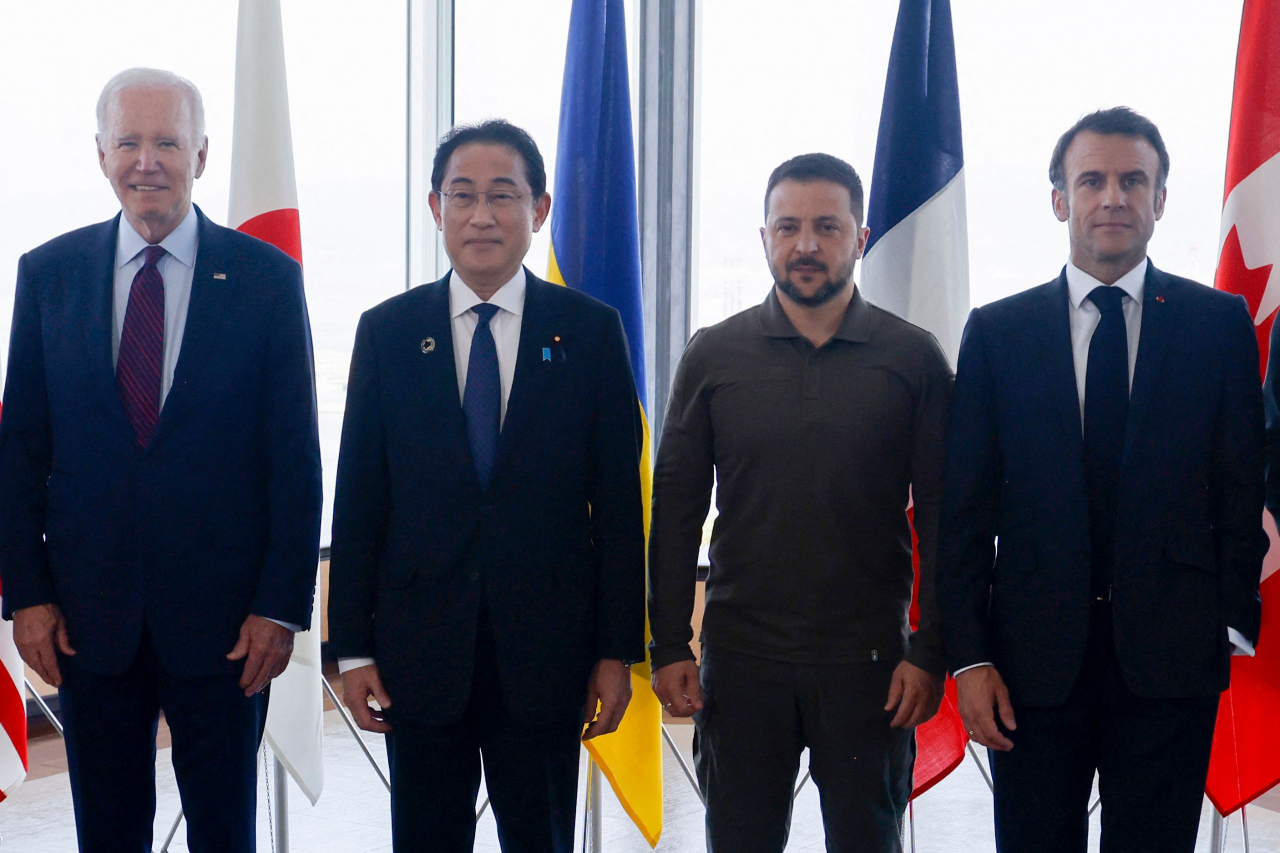Japanese PM faces dilemma at G7 as he balances anti-nuke goals with reality of threats
The 1945 bombing of Hiroshima is a big reason leaders from the world’s most powerful democracies descended on the city for this weekend’s Group of Seven summit
By APPublished : May 21, 2023 - 21:27

HIROSHIMA (AP) -- 8:15 on the morning of Aug. 6, 1945.
It's a big reason leaders from the world's most powerful democracies descended on Hiroshima for this weekend's Group of Seven summit: Part commemoration, part effort to confront the continuing consequences of the moment a US B-29 Superfortress released what the Americans named “Little Boy” over the city in the first wartime use of a nuclear bomb.
It also presents Japanese Prime Minister Fumio Kishida, the driving force behind Hiroshima's selection for the G7 venue, with a unique dilemma.
On the one hand, he is keen to promote the vision of a world without nuclear weapons that has long been a cornerstone of his political rhetoric. On the other, he is mindful of the widespread domestic worry over aggression by nuclear-armed neighbors.
Kishida's difficult balancing act could be clearly seen in the G7's overwhelming focus on building support for Ukraine's defense against nuclear-armed Russia's invasion, highlighted by Ukrainian President Volodymyr Zelenskyy's personal appearance in Hiroshima. There was also sustained G7 pressure on China over its expanding nuclear arsenal, and on North Korea's pursuit of nuclear-tipped missiles that can target the US mainland.
But even as he stood shoulder-to-shoulder with Zelenskyy, whose presence at the summit bolsters Kishida politically, the Japanese leader sought to repeatedly infuse the summit with his ideas about a nuclear-free world.
On both the opening and closing days of a gathering that included four nuclear-armed nations — G7 members France, the U.K., the United States, and visiting participant India — Kishida brought leaders to pay their respects at memorials to the 140,000 people killed by the bomb. They planted a symbolic cherry tree, spoke with a survivor and offered a silent prayer.
Geography is a big reason for Kishida's attention to nuclear disarmament. He represents Hiroshima, where his family is from, in parliament. Although a pro-military conservative, he is politically linked to a city where a fast-dwindling number of elderly bomb survivors are a palpable reminder of one of the most momentous events in human history.
As a child, Kishida heard about the horrors of the atomic bombing from his grandmother, who was from Hiroshima. Her stories left “an indelible mark” and inspired his work for a world without nuclear weapons, said Noriyuki Shikata, Cabinet secretary for public affairs.
But Japan, a liberal democracy, staunch US ally and the world’s third biggest economy, is also located in a dangerous neighborhood.
Wary of China and North Korea, Kishida has been steadily pushing for an expansion of a military constrained by a pacifist constitution primarily written by the Americans after Japan’s World War II defeat. He relies on the so-called US military umbrella, which includes nuclear weapons and the 50,000 US military personnel, and their powerful, high-tech weaponry, stationed in Japan.
To some critics, Kishida’s disarmament goals ring hollow as he simultaneously pushes to double Japan’s defense budget in the next five years and strengthen strike capabilities.
Japan also refuses to sign the Treaty on the Prohibition of Nuclear Weapons, which took effect in 2021. Kishida says it is unworkable because it lacks membership by nuclear states. He maintains that Japan needs to take a realistic approach to bridging the gap between nuclear and non-nuclear states in a challenging world.
“A path to a world without nuclear weapons has become even more difficult,” Kishida said in April. “But that’s why we need to keep raising the flag of our ideal and regain a new momentum.”
On Sunday, the summit's final day, Kishida escorted South Korean President Yoon Suk Yeol to a small memorial honoring Korean victims of the atomic bombing.
That symbolic visit helps reveal the tricky path Kishida follows.
As he paid tribute to victims of the bombing, he was also looking to solidify Japan's security stance by improving a relationship with South Korea that has long been shaky because of unresolved disputes linked to the 1910-1945 Japanese colonization of the Korean Peninsula.
Yoon's office described Kishida’s visit to the memorial as a “courageous act” and said that Washington, Seoul and Tokyo agreed “to strengthen deterrence against North Korea" and improve defense cooperation, including sharing real-time information on North Korean missile launches.
US President Joe Biden said that being in Hiroshima for the G7 was “a powerful reminder of the devastating reality of nuclear war” and a reminder of countries’ shared responsibility to work for peace. But Biden also stressed Sunday a willingness to challenge Russia by helping Ukrainians defend themselves.
Kishida's meetings at the summit with Biden and Yoon are “an occasion to show the other team, the China-Russia-North Korea coalition, solidarity among the democracies in the region and their resolve to stand up to the increasingly threatening autocracies,” said Sung-Yoon Lee, an East Asia expert at Tufts University’s Fletcher School of Law and Diplomacy.
Kishida, Yoon and Biden's joint focus on victims of the bombing, Lee said, "sends an implicit message to China, Russia and North Korea: We will never forget."








![[Graphic News] More Koreans say they plan long-distance trips this year](http://res.heraldm.com/phpwas/restmb_idxmake.php?idx=644&simg=/content/image/2024/04/17/20240417050828_0.gif&u=)
![[KH Explains] Hyundai's full hybrid edge to pay off amid slow transition to pure EVs](http://res.heraldm.com/phpwas/restmb_idxmake.php?idx=644&simg=/content/image/2024/04/18/20240418050645_0.jpg&u=20240419100350)






![[From the Scene] Monks, Buddhists hail return of remains of Buddhas](http://res.heraldm.com/phpwas/restmb_idxmake.php?idx=652&simg=/content/image/2024/04/19/20240419050617_0.jpg&u=20240419175937)

![[KH Explains] Hyundai's full hybrid edge to pay off amid slow transition to pure EVs](http://res.heraldm.com/phpwas/restmb_idxmake.php?idx=652&simg=/content/image/2024/04/18/20240418050645_0.jpg&u=20240419100350)

![[Today’s K-pop] Illit drops debut single remix](http://res.heraldm.com/phpwas/restmb_idxmake.php?idx=642&simg=/content/image/2024/04/19/20240419050612_0.jpg&u=)